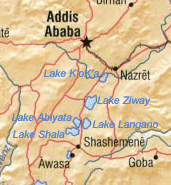Lake Ziway
| Lake Zway | |
|---|---|
 | |
 | |
| Coordinates | 8°00′N 38°50′E / 8.000°N 38.833°E |
| Basin countries | Ethiopia |
| Max. length | 31 km |
| Max. width | 20 km |
| Surface area | 440 km² |
| Max. depth | 8.9 m |
| Surface elevation | 1,636 m |
| Islands | 5 (Debre Sina, Galila, Bird Island, Tulu Gudo) |
| Settlements | Ziway |
Lake Zway or Lake Ziway is one of the freshwater Rift Valley lakes of Ethiopia. It is located about 100 miles south of Addis Ababa,[1] on the border between the Regions (or kililoch) of Oromia and of the Southern Nations, Nationalities, and Peoples; the woredas holding the lake's shoreline are Adami Tullu and Jido Kombolcha, Dugda Bora, and Ziway Dugda. The town of Ziway lies on the lake's western shore. The lake is fed primarily by two rivers, the Meki from the west and the Katar from the east, and is drained by the Bulbar which empties into Lake Abijatta. The lake's catchment has an area of 7025 square kilometers.[2]
Lake Zway is 31 kilometers long and 20 km wide, with a surface area of 440 square kilometers. It has a maximum depth of 9 meters and is at an elevation of 1,636 meters.[3][4] According to the Statistical Abstract of Ethiopia for 1967/68, Lake Zway is 25 kilometers long and 20 km wide, with a surface area of 434 square kilometers. It has a maximum depth of 4 meters and is at an elevation of 1,846 meters.[5] It contains five islands, including Debre Sina, Galila, Bird Island and Tulu Gudo, which is home to a monastery said to have housed the Ark of the Covenant around the ninth century. The early 20th-century explorer Herbert Weld Blundell describes finding that "two distinct terraces of former shores rise some 80 feet above the present level, forming a ring round that nearest to the lake on the north, about 4 miles from the shore, marking a former basin." The northern shores were covered by papyrus. Weld Blundell includes in his account "a curious tradition, perhaps suggested by the apparent elevated shore," that the lake "was a kingdom 50 miles across, inhabited by seventy-eight chiefs" which disappeared in a single night.[6]
The lake is known for its population of birds and hippopotamuses. Lake Zway supports a fishing industry; according to the Ethiopian Department of Fisheries and Aquaculture, 2,454 tonnes of fish are landed each year, which the department estimates is 83% of its sustainable amount.[7]
The shores and islands of Lake Zway are the home of the Zay people. Tradition states that when the Muslim Ahmad ibn Ibrahim al-Ghazi conquered Ethiopia, the Christians of the area took refuge on its islands. They were later isolated from the rest of Ethiopia by the Oromo people, who settled around the lake. At the time Menelik II conquered the lands around the lake, the lake-dwellers were rediscovered and found to have preserved both their Christian faith and a number of ancient manuscripts.[8]
Notes
- ^ Leslau, Wolf (1999). Zway Ethiopic Documents: Grammar and Dictionary. Wiesbaden: Otto Harrassowitz. p. xv. ISBN 3447041625.
- ^ Robert Mepham, R. H. Hughes, and J. S. Hughes, A directory of African wetlands, (Cambridge: IUCN, UNEP and WCMC, 1992), p. 158
- ^ "Water Resources and Irrigation Development in Ethiopia - IWMI", Table 3. Basic hydrological data of lakes and reservoirs of Ethiopia. (accessed 2 July 2011)
- ^ Google Earth
- ^ "Climate, 2008 National Statistics (Abstract)", Table A.2. Central Statistical Agency website (accessed 26 December 2009)
- ^ H. Weld Blundell, "Exploration in the Abai Basin, Abyssinia", The Geographical Journal, 27 (1906), pp. 529-551
- ^ "Information on Fisheries Management in the Federal Democratic Republic of Ethiopia" (report dated January, 2003)
- ^ Paul B. Henze, Layers of Time: A History of Ethiopia (New York: Palgrave, 2000), pp. 113f, 152
